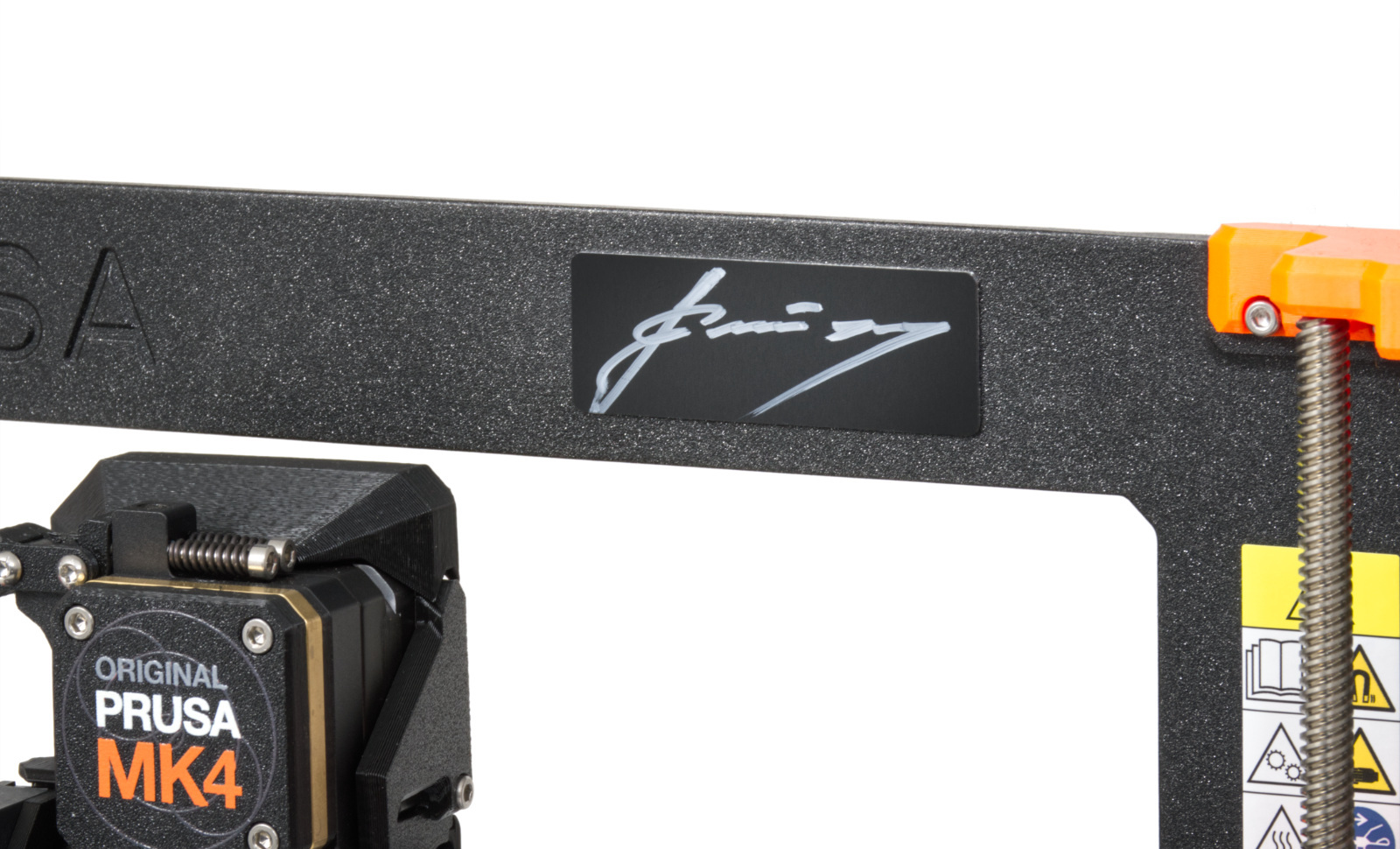How do I get the kit or assembled printer owner discount?
As stated on our website: Prusa3D, if you purchase an assembled MK3S+ printer, we offer a 10% discount on your upcoming five subsequent purchases of an assembled printer of the same type and on 30 spools of selected filaments per year (not applicable to the MK4). If you choose to purchase your printer as a kit, we offer a 5% discount on 30 spools of selected filaments per year. In both cases, the discount is automatically activated in your account as soon as your first kit or printer is shipped.
Can I have my printer signed by Jo?
Yes, Josef can sign the machined aluminum card, which can then be attached to the printer in your preferred location, but please know it can delay the expedition for over a month. He is very busy these days. If it's OK with you, you can ask for the signature in an email or via Live Chat.

What are the printer dimensions?
The dimensions are (W×L×H or X×Y×Z):
- An assembled MK4/S, MK3.9 printer measures 500×550×400 mm | 19.6×21.6×15.7 in, and 7 kg, without filament spool.
- MK4 print volume: 250×210×220 mm | 9.84×8.2×8.6 in.
- An assembled MK3/S/+, MK3.5/S printer measures 500×550×400 mm | 19.6×21.6×15.7 in, and 7 kg, without filament spool.
- MK3/S/+, MK3.5 print volume: 250×210×210 mm | 9.84×8.2×8.2 in.
- An assembled XL printer measures 580×700×900 mm | 22.83 ×27.56 × 35.43 in, and has a maximum weight of 25.3 kg. The width includes the Wi-Fi antenna and filament side sensor, and the height includes the cables to the extruder(s).
- The assembled XL printer measurements with side spool holders and top enclosure cover (separate future add-on) are 800×800×900 mm | 31.49×31.49×35.43 in.
- XL print volume: 360×360×360 mm | 14.17×14.17×14.17 in.
- An assembled MINI/+ printer measures 320×330×380 mm | 12.6×13×15 in, and 5 kg.
- MINI/+ print volume: 180×180×180 mm | 7×7×7 in.
- An assembled SL1S printer measures 225x237x400 mm | 8.8×9.3×15.7 in, and 11 kg.
- SL1S print area: 127×80×150 mm | 5.0×3.1×5.9 in.
- An assembled SL1 printer measures 220×240×415 mm | 8.7×9.45×16.3 in, and 11 kg.
- SL1 print area: 120×68×150 mm | 4.7×2.6×5.9 in.
What is the printing precision/tolerance of the Original Prusa?
According to our testing, the precision tolerance of a well-assembled Original Prusa printer is 0,1 mm on the Z-axis and 0,3 mm on X and Y. It can be as little as 0,05 mm on all axes, after making additional calibrations such as the Extrusion multiplier calibration and Extruder linearity correction.
However, please note that the material is also relevant: it can shrink while cooling down, and low-quality filaments with uneven diameters will cause uneven extrusion. The optimization of the model for 3D printing (overhangs, etc.) is also important. Our printers are tested even for the 0.25 mm nozzle, which is more precise compared to the standard/stock nozzle with a 0.4 mm diameter.
What tools do I need when working with my Original Prusa?
All necessary tools (pliers, screwdriver, hex keys, wrenches…) are included in the package. If you are wondering what else you could need, here is a list of some nice-to-have things:
- 3.5'' side-cutter/flush-cutter pliers
- White permanent marker
- Compressed air
- A big bottle of IPA 91% to clean the sheet
- Acetone (only with the smooth sheet)
What is the life expectancy of the printer?
According to our testing, the average maintenance interval of our printers is around 800 print hours. When it needs to be serviced, most frequently, it’s the nozzle that needs to be changed, and then it can continue printing for many hundreds of hours more.
What is the power consumption of a PRUSA printer?
The average power consumption that we have measured on an MK-series printer, at 26 °C (room temperature), is 80 W when printing generic PLA and 120 W when printing generic ABS.